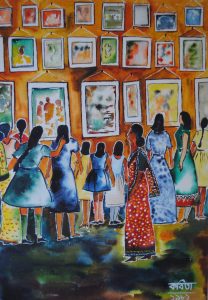- International Classroom Art Exchange
- Art and Culture Activity Ideas
- Teaching Art and Global Awareness
Teaching art and awareness is the first step. It requires a lot of dialogue, inclusivity, diversity, and above all, open minds. With our teachers and students, we like to first focus on the 8 Studio Habits of Mind (developed by Project Zero through the Harvard Graduate School of Education), which you can find below. These habits of mind start in the studio, but they carry us throughout our multicultural education and are vitally important skills for any person to become a conscientious global citizen.
Studio Thinking Framework: Eight Habits of Mind
1. Develop Craft

2. Engage & Persist

3. Envision

4. Express

5. Observe

6. Reflect

7. Stretch & Explore

8. Understand Art World

Teaching global awareness and cultural understanding comes next. What we have found is that it is best for each individual teacher, parent, classroom, and/or community group to be deeply involved in the curriculum, since they know their students and children best. They know how they learn and think, how to best keep them engaged, and how to deal with difficult topics.
For us, based in the Silicon Valley and Bay Area, we have a lot of diversity. Two of our largest populations, and those that we have the largest collection of art from, are China and India. So we developed a global awareness curriculum centered around these countries, which you can download below. This curriculum looks specifically at China and India, but can be easily modified for other regions and countries, particularly with the use of our Online Teaching Museum.
For a downloadable curriculum plan centered on China and India, click the link below. This folder includes:
- A detailed curriculum and lesson plans
- Sample artworks from China and India, corresponding to each lesson
- Document copy of the 8 Studio Habits of Mind
Paintbrush Diplomacy China-India Curriculum
Please feel free to reach out to us via our Contact Us page or email us directly at paintbrush4diplomacy@gmail.com with any questions you may have. You can also subscribe to our email list for art and teaching updates!

